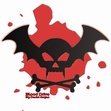Daniel Aegan's Blog, page 2
February 6, 2024
Daniel’s Journal #76 – Assemble!
With so many teams in all forms of literature and entertainment, it’s sometimes difficult to choose your favorite. Whether it’s a superhero team like the Avengers or X-Men, a group of travelers and adventures like The Fellowship of the Ring in the Lord of the Rings trilogy, or a circle of friends like in…Friends. What can be more daunting for a writer is to create their own ensemble from the void. I’ve written several for my books. They don’t always get along, their belief systems don’t necessarily align, and they don’t mesh well together. This can lead to a chaotic mixture that can endear them to your readers or frustrate them.
Lucky for you, I’ve decided to share some insights from my experience putting together ensembled characters for my books. So grab a friend or three and get ready to rumble.
First off, you need a common goal. Otherwise, why would your team get together in the first place? For The Avengers, it’s fighting bad guys like Loki, Ultron, or Thanos. For The Fellowship of the Ring, it’s getting that darn ring to Mordor. In the case of Friends, it’s…um…living in New York on an unrealistic budget? Whatever the case, you don’t have an ensemble if they’re all walking in different directions. What you have there is a pointless mess on your hands.
Next, realize your ensemble doesn’t have to get along. Just because they’re after the same MacGuffin doesn’t mean that have to be all smiles and fist bumps while searching for it. The fallout of your group adds some tension and acts as a side story of your main plot, giving your readers something else onto which to latch. A tiff, argument, or a full-blown fight doesn’t have to be the driving force of the plot, but it should act as a catalyst to move it along. In the case of sitcoms or serial stories, this happens often as a way to drive individual episodes. In this case, it can go stale, so be careful if you’re venturing into these waters.
Another example of this would be a found family narrative. This is where your character would be separated from their kinfolk, whether by choice, force, or death, making them form a family bond with their new group. The Japanese use the word “nakama” to denote a group with deep bonds and a shared destiny, adding layers to the whole “found family” dynamic. This word is often translated to “comrades” or “friends”, but it has a deeper meaning. The best example of this is the anime One Piece, where a boy named Monkey D. Luffy puts together a pirate crew who becomes the family he never had. His nakama.
Each character in your ensemble should have their own voice and personality. Don’t let them blend into the group like a lemming. If they have issues with the appointed leader of the group or has a personal vendetta against another member of it, don’t let them lose it. Characters falling into a hivemind-like mentality is a common pitfall seen a lot in traditionally published books. Managing your characters’ separate personalities is essential to building your ensemble.
Now for the part where I talk about my books.
I’ve been writing ensemble pieces since I began this whole author brand of mine. My first book, Blood Drive (which turned into a thrillogy), sees an ensemble of two vampires, a redneck werewolf, a trigger-happy priest, and a pair of mafioso wannabes. They clash, they fight, they may not all make it to the final chapter of the third book, but they work as an entertaining ensemble (or so I’ve been told by readers). My next book, a sci-fi comedy called Humans Are Trash, focuses on a group of six wealthy people trapped on a space shuttle in outer space. This ensemble features an A-list actor, a pop star, a tech billionaire, a social media influencer, a rapper, and the son of a United States Senator. They don’t get along at all and are at each other’s throats from the start, but they have the common goal of getting home to keep them working together as best they can.
I have more books out there or on the way with more ensembles, but I think naming those two would be enough. Well, indulge me one more… My work-in-progress is a medieval superhero piece called Freek Squad involving a group of heroes trying to save the kingdom from an evil necromancer and his band of baddies. You see their common goals, their infighting, and the development of their bond during the course of the story. Will they become a nakama, or do they decide their paths diverge in different directions? You’ll have to wait for me to finish this one to find out! Look for it in 2027!
If you find yourself overwhelmed writing an ensemble story of your own, it helps to keep a running list or a cheat sheet of the characters in it with a little personality description in case you get lost. I’ll also list their individual character arcs and draw lines to where they intersect with their fellows’ parts of the plot, creating a tangled web of terse friendship and budding comradery. This can get messy, so keeping this close at hand while you’re writing can be a big help. The last thing you need is to go back and crowbar in some character development for one of your ensemble members you forgot to give one of them something worthwhile to do. Trust me, I’ve been there.
I’ll cap it off here, even though there’s a lot more to say about this subject. If you want to throw your two cents into the mix, hit me up on BlueSky and start a conversation. Everyone has their own way to do things, and you’re not wrong if you set your ensemble up differently than mine. Now put together your roster, assign everyone their roles, and assemble your team!
-Daniel Aegan—2/7/24
***
See a vampiric ensemble in action in The Blood Drive thrillogy! It’s full of action, laughs, and gallons of blood!
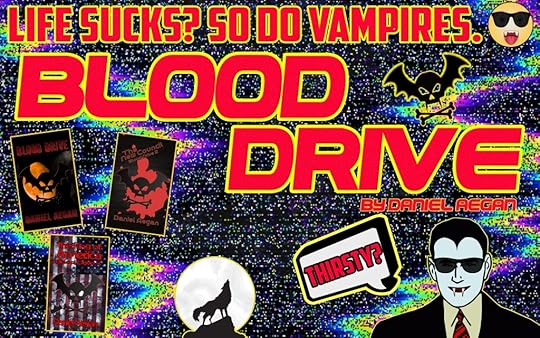 Blood Drive: Available on the ‘Zon
Blood Drive: Available on the ‘Zon
January 29, 2024
Daniel’s Journal #75 – An Abundance of Dumpage
We’ve all seen the dumps and left some of our own. Well, some of us have. It gets smeared all over the page, obscuring your intended meanings, making a mess out of an ordinarily clean narrative.
I’m speaking, of course, about info-dumping.
Every writer and reader has an opinion about this issue. Some deem in necessary in order to build a world either on paper or in their heads. Others employ subtlety in world-building, allowing it to unfold as the character or characters experience it on their journey. Then, there are those who don’t care either way.
To put it out there right at the start (or three paragraphs from the start at least), I’m the more subtle type of writer and reader. I’m not too big on using tons of words to describe a world when it’s not necessary to the piece of the plot being laid out. If my character needs to head to the enchanted forest to continue their quest (I’m writing a fantasy at the moment, so excuse the trope), then that forest will be described as he traverses through it. This all goes back to the “show don’t tell” writing advice that wafts around social media every now and then. On that matter, I’m of the “show and sometimes tell” mindset of things, but that’s a separate issue altogether. Writers like Stephen King get a lot of newbie writers to lay the description on so thick you wind up with multiple pages to describe something that’s not that important to the plot. Don’t get me wrong here; description is important, but so is subtlety.
Getting back to world-building, it’s easy to fall into the trap of over-description when it comes to writing your book. It’s understandable to want to “paint a picture with words” to give your readers an immersive experience when they dive into your story. They may feel, despite your best efforts, that you’re beating them over the head like J.R.R. Tolkien on crack. I get that some authors thrive in this arena. I say more power to ‘em. There are cases where the world itself is a character, and the reader needs to know all these little tidbits on how magic and science and whatever else works in its ecosystem. That feels more like a niche than the norm. Don’t forget that some readers feel that the extra info-dumping is a ploy to increase the word count.
Ah, yes, we’re going to be speaking about word count next.
Repeat this phrase in your head with your mind’s best Tyler Durden voice: “Stories will be as long as they have to!” That being said, I recently had a conversation about word counts in books. I was told in no uncertain terms that if you want to query and compete with other authors vying for an agent in the competitive world of professional book querying, you’ll need to be around ninety thousand words, and the genre doesn’t matter. If you’ve gone over that mark, you might as well pack it up. No agent, no book deal, no anything—all because you had to have a book with ninety thousand and one words. I hope you’re happy with yourself! If you want to go over that mark, you’ll have to split it up into two books, so you might as well query it as “Book One of the Frosty Testicles Series” or whatever world event in which your book takes place.
Alright, I may have gotten too overcritical with the querying process in that last paragraph, but I take a heaping spoonful of umbrage with it. I won’t get into it now. Maybe that’ll be a topic for a future piece where I rant about choosing self-publishing, staying indie, and doing whatever the heck I want with my books.
Word count and/or page count may be the least important thing about your story. I don’t care what anyone has to say about it. Agents are looking for clones of what’s already selling. Most of them are unwilling to take risks. Well, the ones who accept queries from new authors they don’t know aren’t. Those who can afford to take the risk of grabbing an unknown author with a book with a decent twist on an existing genre aren’t scrolling social media hashtag agent games or poring over query letters from their email inbox into the deep, dark hours of the night searching for the special book to make them a boatload of money.
I feel like I’ve gone off the rails and fallen into a rant I promised not to make. I guarantee you it’s relevant, even if it does sound a bit snippy. Ninety thousand words is my average book length. It’s actually ninety-three thousand, eight hundred and forty-seven words based on what I’ve published (yes, I keep track of all the numbers). Confidentially speaking, the average word count of my books published and unpublished combined is just under a hundred thousand. This likely happened since I’ve written some chonky sci-fi and fantasy books coming soon. Elvenweed (2025), a comedy/fantasy novel about an elf selling elven-grown cannabis in a human kingdom, is around a hundred and sixty thousand words long, throwing off the total average.
But why am I telling you this in a piece I dedicated to talking about info-dumps and overdescription? I’m trying to prove a point, trust me. The elements of my world-building are there, but I don’t spend page after page in the opening chapters describing it. Another piece of aforementioned social media writing advice that went around a few years ago was how to start your books. It’s one of the tips with which I agree. The first sentence should throw your character ass-first into the story. For instance, the aforementioned Elvenweed book begins with the squire character lost in an enchanted forest after his squadron of knights left him behind. There isn’t a pause to add lengthy descriptions about the kingdom, the world in which it’s set, or the hierarchies included within it. That stuff comes later when the story dictates it. The world-building elements are embedded into the story subtly. The main reason for the high word count in Elvenweed comes from the large ensemble cast and a handful of crisscrossing story arcs. Sure, I can split this into two or maybe three books, but it’s all one story. Besides, I’m leary about putting out a series since “Book One of The Elvenweed Chronicles” may be a bit of a pill to swallow for a reader. They don’t know what to expect, so they may not want to start a series with no guarantee it will be good.
OK, time for another side-rant. I don’t enjoy writing books as part of a series. Some of my readers have asked me about sequels to particular books they enjoyed, but I always have the same response. I don’t plan to have sequels because I’m not interested in writing any of my plot ideas into full-blown series. The only exception to this was the Blood Drive Thrillogy (now available on the ‘Zon). I only did the second book because I got a really good idea for one, and I hadn’t thought of making the third book until I got to the end of writing the second book and realized there was more story to be told. The fourth book, a collection of shorts from the Blood Drive world called Blood Drives (get it?!), will drop in 2025 and finish filling in the blanks of that world. Again, subtly. The key for me doing this was having separate stories that aren’t direct sequels. You can pick any of them up and still get a complete story.
As a reader, I read books and stories of all lengths. Some of my favorites were novellas, barely over thirty thousand words. I’ve dove into era-spanning fantasies of four hundred thousand words or more, and I’ve also read epic series based around a singular character or world. I loved them all for various reasons, and the word count wasn’t important. A longer book can be daunting for some, but it goes double when that reader bases their decision on a review or a post on social media that’s blasting it for being bogged down with unnecessary world-building or narration.
They do this in movies too—maybe more so than in books. The most glaring example off the top of my head is the beginning of Marvel’s The Eternals. It begins with a narration about how the world, the stakes, and the heroes and villains of the movie operate. It’s a hundred percent unnecessary since all the information was written subtly into the story itself. Giving it all away at the start was a disservice to anyone in the theater or streaming it six months later. I get the feeling some movie exec at Disney who hires people to open his soda cans for him decided that subtle wasn’t the way to go and made the director tack on the narration so people wouldn’t complain it was too smart for a superhero movie. It’s a great movie, and that dumbing-down of the world-building at the start condescends like a sonofabitch.
I feel like this blog piece went off the rails a bit and for way too long, so I’m going to cut it off here. See, I can keep my word count short when necessary! There’s nothing inherently wrong with being prolific. If you’ve got a long story to tell, do it in whatever way you see fit. At the end of it all, you don’t have to listen to anything I’ve said here or any other writing advice found on the interwebs. A lot of this is my opinion based on my experiences. Don’t forget that it may be your world, but your readers also have to live in it. If they feel like you’re bogging them down with your narrative style of dumping everything on them all at once, you’re going to induce some yawns instead of excitement. Be cognizant of what you’re telegraphing in your stories, and keep a level head about building your world.
Subtly yours,
Daniel Aegan–1/31/24
****
Looking to see some subtle world-building in action? Check out the latest by Daniel Aegan: In Search of Channel Void. It’s full of tons of sci-fi goodies, episodic chapters, and a cosmic energy storm that reshapes the world while twisting reality’s nipples. Don’t believe me? Read it for yourself!
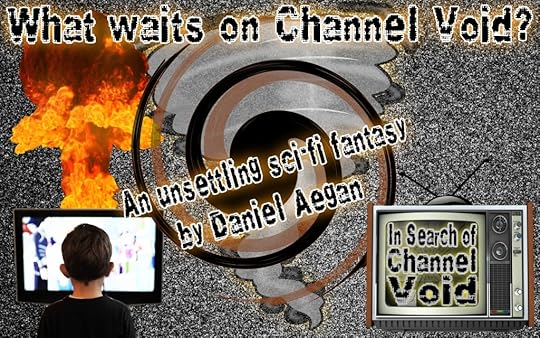
January 25, 2024
Daniel’s Journal #74 – Changes Are Coming Soon(ish)
Change is good, and the time has come for one. No, I’m not announcing my candidacy into the political arena. Those cucks couldn’t handle me on my worst day. I’m talking about how I’m handling my social media posting, this blog, and what I’ll be sharing.
Oh yeah, SmoreWords is returning too.
I had a bit of a thing earlier this week. I won’t say it was a “breakdown” or anything like it. It was more of a lull in programming. I didn’t feel connected to the indie writing community any more, even the queer side of it where I had once thrived and made so many friends and followers. All that changed. Things took a hard left turn as they tend to do. A big piece of the puzzle has been missing lately, and it’s been that way since I left the dead bird app last year.
I went on a bit about this in my last post, so if you want to catch up, check it out here: What The Hell Have I Been Doing?
Getting back on topic, I wound up leaving most of my following behind when I left Twitter, starting it all from the square one on BlueSky. This meant my bookish tweets, Stoned Tarot side gig, and everything else had to be replanted to grow in a new, unfamiliar place. Thus far, I’ve failed at cultivating, and I’ve started to feel like I’ve been left behind because of it.
Now I know this is all my own fault. I know the snubbing happened because I’m not putting enough of myself out into the digital realm. That’s on me. I’ve been content shit-posting and dropping a “just a reminder that I also write books” post here and there with a seldom Instagram post, an even more seldom Tumblr microblog piece, and an incredibly rare blog. I also stopped doing SmoreWords completely. If you hadn’t played back when I did this on Twitter, SmoreWords is a game I took over from the great Charlie Knight when they decided to give it up to focus their energy elsewhere. It’s a daily game asking authors about their projects with a fun twist and personal accountability goals. BlueSky was a new frontier for me, and I fell off setting up the daily posts.
SmoreWords, as mentioned above, will be the first thing to return. Monday-Saturday will have a daily post for anyone who wants to participate. I’m sure it’ll take a while to build it back up, but I’m happy to put in the time. You’re also going to see me posting more about my books and fun stuff about them across the three platforms I’m currently using (BlueSky, Instagram, and Tumblr if you’re not paying attention). This will include a weekly microblog on Tumblr. I’ll also be dropping a weekly blog piece here in the form of Daniel’s Journal. I may even go back to doing indie author interviews.
This is my first step into rebranding(ish) and putting out more interactive stuff instead of whining and posting pretty much nonsense. I’ve done my writing a disservice by failing to keep this game going. As much as it loathes me to admit this, proof is in how poorly In Search of Channel Void did when I released it this past November when it’s a solid sci-fi book and some of my best work (if I can sniff my own fart for a moment). Channel Void deserved better from me, and I don’t want to repeat these mistakes with my future releases.
 Check out In Search of Channel Void for yourself!
Check out In Search of Channel Void for yourself!In Search of Channel Void on the ‘Zon!
I don’t know if anyone will read this far into this post or assume I’m writing an apology to myself and shipping into the void. If you have, than you for indulging me. I hope you stick around for what’s coming.
-Daniel Aegan 1/25/24
January 3, 2024
Daniel’s Journal #73 – What the Hell Have I Been Doing?!
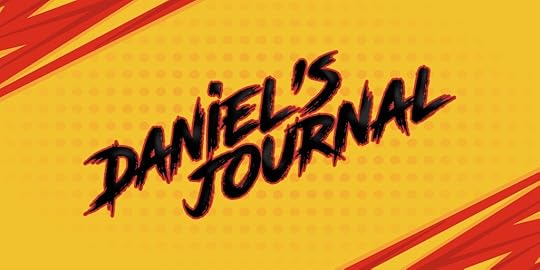
OK, so it’s been a long time since I’ve done one of these. A VERY long time. I’ve meant to do more updates, really, but I had sort of blogger’s block. It hasn’t stopped me from working on my stories and other nonsense, but I couldn’t seem to get myself in the mood to sit down and write a blog post–not even on the toilet at work if you could believe that! Most recently–and by that I mean around a month or so ago–I wanted to do an “end of the year” post that led into what’s coming in 2024. Since I missed that date and it’s been a new year for three whole days, allow me to regale you with an update in the life of Daniel Aegan.
As some of you no doubt know, I’ve been sick with Covid since Christmas. Yes, it’s still out there, and this is my third time dealing with it. It’s not as bad this time around since I got the most recent vax in September. It’s felt like a nasty head cold, but I’ve still had to quarantine during the second half of my year-end vacation, and I wound up using two sick days to start off the new year. This is a big deal since my company only gives me four of them before I have to start dipping into my vacation bank. But it’s OK since we’re no long allowed to work from home or have any support when we do get Covid or any other illness, not since we decided as a country that it’s not a big deal any more. That was sarcasm, by the way…
But I’m not here to start a rant about that bullshit. I’ll save it for another day.
2023 was a good year for me writing-wise. Sure, some other good stuff happened, but let’s not focus on any of that. For all of you who were with my during my Twitter days, you no doubt know I left that platform the moment the child porn started popping up due to the new owner’s lack of regulations. There were a lot of reasons to leave Twitter–now known to me as the Dead Bird App–but that was the straw. Did it hurt to leave the platform where I made a lot of writer friends and cultivated my brand to move onto a relatively unknown, invite-only social site called BlueSky? Oh yeah, but things die. It’s what they do. Thanks, God! Still, losing my following and people who went to different apps was a blow I still haven’t fully grasped. Then again, I should’ve blogged about this months ago when it was more relevant, and I’m supposed to be updating you on my writing stuff.
Getting back to it, my first book drop of the year was a villainpunk book called Bad News. This was an idea that came from watching certain news and media personalities go whole hog into presenting terrible people as demigods here from Mount Olympus to save us from the evils of the opposite side of the political spectrum. I thought about what that would look like in a world of superheroes if a media outlet decided that it would be more profitable to present the villains of their world as the saviors and do what it can to turn the people against the superhero community. This being my second villainpunk book following Reign of the Unfortunate from the year before, I decided to look at worlds like this from a whole new perspective. This isn’t about the superheroes or supervillains–not exactly. This is more about the regular-ass people who have to live in a world full of extraordinary individuals treated like gods. This story followed a young man by the name of Randy “Figs” Figueroa who was given the reins to a failing media empire in a city full of superpowered people and how he viewed the blurry lines between what society tells us are heroes and villains. It’s a gritty and unapologetic story with enough twists to keep you wondering what the hell is going to happen next. This should go without saying for an Aegan Multiverse book, but there’s a heavy dose of queerness in it as well.
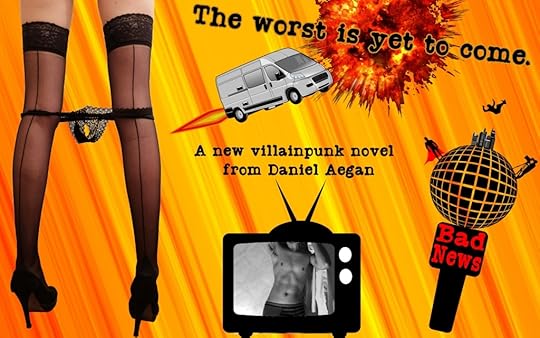
I followed Bad News later that year with a collection of new and old short stories called Infinite Zero, a follow-up to the Double Zero that came out in 2020. This had nine stories in the realm of sci-fi, fantasy, villainpunk, horror, and more in the same style you’ve come to know and love–assuming you know and love my work. It was a fun book to put together with a wide diversity of stories. I’ve got stories in here about eighties’ video game tournaments gone awry, superhero sidekicks out for revenge, roller derby champions fighting deranged wildlife, retail multiverse shenanigans, devour or worlds falling in love, and a ton more. I could sit here all day describing the many stories of this collection, but I’ll spare you a blow-by-blow rundown and just tell you it’s a book full of stories that are shorter than average but make up for it in spunkiness.

Oh, and if you haven’t noticed, I started making my book ads weirder. I’m really enjoying that cringy aesthetic. You can thank my fellow indie writer PK Reeves for that.
There’s on more book I dropped in 2023 I want to talk about before moving onto what’s coming in 2024, but I want to address the “three books a year” thing since so many people ask me about how i get so much accomplished. I’ve said this before, but I’m an engineer by trade, so my mind works on that level as well as a creative one. When I started writing ten years ago–yes, it’s also the ten-year anniversary of when I started writing all this nonsense–I did it all in a haphazard fashion and posted stories on blog sites and e-mags that are now dead and gone. After that, I began attempting to query my work to no avail, being told there’s no market for the type of genres and style, even though these same people were also telling me not to quit because my stuff was worth writing and publishing. My sad and dehumanizing querying adventures is another blog post I should write at some point, but I’ve digressed once again. I started a three-year process per book, meaning from start to finish, it takes three years for me to get a book out. I also started cycling through stories, so every year I have a first, second, and third drafts of different books that I go through. In between these drafts there are alpha and beta readers helping me out, and I do take time to return the favor. This type of creative work load doesn’t seem to work for many, but it’s worked for me. At this moment in time I’m working on the first draft of a book called Freek Squad that should see it’s release in 2026. This whole system keeps me busy during all my breaks and lunches at work as well as my down time at home, but it’s a worthwhile endeavor. I’m actually ahead of the game this year since I was able to get the second draft of Safe Haven done and off to a beta reader during my December vacation thanks to my quarantine. It’s also helped me get the first three chapters of the aforementioned Freek Squad written.
Getting back to 2023’s book list brings us to In Search of Channel Void, my third and final release of the year. This book is among my favorite, and was inspired by a stoned watching of the Twilight Zone New Years Eve marathon. Channel Void pays homage to Rod Serling and his creation, bringing the reader into a world where the episodes of an odd TV show from the sixties may be real. When Paul, our main character, heads to the southwest to find the clues on whether or not his favorite show actually happened, he finds a lot more than he bargained for. New friends and weird clues point him in the direction of a multiverse-bending energy storm that the now deceased creator of the Channel Void show was rumored to follow to get inspiration for the episodes of his show. It turns out everything may be realer than he could ever imagine, and chasing down the energy storm might cost him more than he’d calculated. This is a sci-fi romp with lots of heart, a dash of pothead humor, and lots of queer vibes. I’m so very proud of this one and how it encapsulates what I wanted to put out while stoned and watching Twilight Zone. I know I’ll never know for sure, but I bet Mr. Serling would approve.

As a side note here, I added Amazon links to images for the books above, but I’d be remiss if I didn’t mention I’ve expanded to a wider realm. Earlier this year I began selling on other sites such as Barnes & Nobel, Kobo Plus, Smashwords, and more. Not all my titles are available as of now, but these last three books and a few others have been added already. So, if you want to read my junk and not a fan of the ‘zon, you’ve got your choices.
Now on to 2024!
This year I plan on dropping another three books. The first is called Humans Are Trash, and it follows a group of wealthy American elitists on a space flight that gets lost in the universe. With a tagline like “The worst people of Earth are humanity’s only hope” you know it’s going to be a lot of fun. This was inspired, of course, by the billionaire space race where Earth’s richest douchebags fired themselves into space in giant dildos. I wish this book was out when that stupid submarine imploded since that event mirrors the theme of this book’s inciting incident. I plan on dropping this one around March(ish), so look for me to be building it up more at some point. For now I’ll say this book was a lot of fun to write and goes harder into sci-fi than I have before aside from I’m in Sci-Fi Hell from 2021. If you want to know what me doing a hard sci-fi book is like, check that beast out.
My mid-year summer blockbuster will be my third villainpunk book titled My Good Friend Dr. Debaucherous. As a note, I did plan to blog about villainpunk, and I still might do it in the near future. Someone remind me if you don’t see it. Dr. Debaucherous follows in the footsteps of Bad News and Reign of the Unfortunate, following a twenty-something man looking for the mentorship of a supervillain. He finds it in a bad guy long thought dead named Dr. Debaucherous if you couldn’t figure that out from the title. This one is a non-linear tale that starts from the bottom of the bottom to the top of high society and back again. It revels in the themes started in Bad News and how a society views its heroes and villains, this time from those deep in the shit. Look for this one around July or so.
Finally, I’m going to finish the year with my long-awaited return to horror-comedy with Who the Fuck is Rocky Phantasmic?! I don’t remember what exactly inspired me to write this one, but it turned out to be a menagerie of cosmic horror, comedy, superhero action, and lots of other bullshit that shouldn’t be mashed with the rest of it. The story works, though! I can’t wait for this clusterfuck of a story to drop. There’s a little something for everyone in this book as long as that something is sex, demons, outspoken comedians who deserve their comeuppance, satire, and lots more. And this will be the first cover featuring my sexy friend Heather, so check it out for her if nothing else!
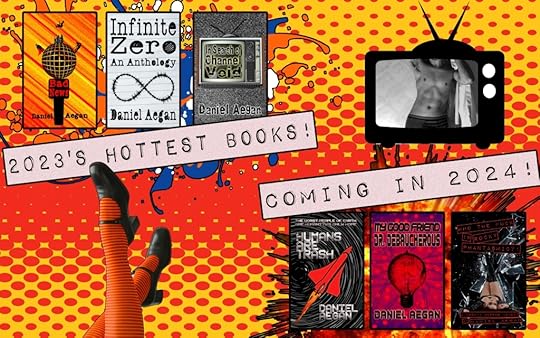
Well, that concludes this blog piece. I hope you stuck with it through to the end. If you have, congratulations. I hope you had fun reading about what I’ve been doing and what’s coming next from the Aegan Multiverse. Also, I’ve written so many books I started encompassing them in what I’m calling the “Aegan Multiverse” if you hadn’t noticed. If you get me going about it, I’ll tell you how it all works. Aside from publishing these three books and working on what’s coming in the future, I’ll be attempting to reboot my Stone Tarot services at some point since Twitter’s demise really fucked up that side hustle of mind. So if you’re a fan of weed and tarot or want an in-depth no-nonsense reading, hit me up through my Stoned Tarot page. I won’t be reading this week while I get over Covid, but I do plan on somehow boosting this once more.

I hope to be seeing you all around the cyber watercooler. As always, you can find my on BlueSky here: https://bsky.app/profile/danielaegan.bsky.social if you’re on that app. I do plan on utilizing it more.
Later!
July 14, 2023
Just Desserts
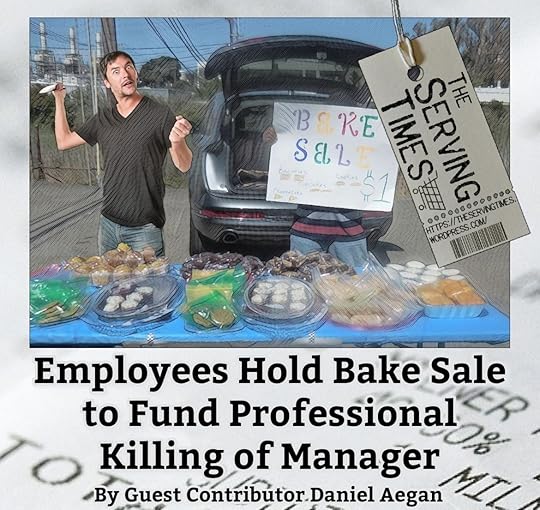
Story by Daniel Aegan (@Daniel_Aegan) It was a sunny Sunday morning when the employees of a Shady Haven Star-Mart showed up to have a little sale not…
Just Desserts
April 4, 2023
Blue Check Special

Story by Guest Contributor Daniel Aegan (@Daniel_Aegan) Grocery shopping isn’t something a lot of people look forward to doing. Most people want to …
Blue Check Special
February 18, 2023
Adventures in Formatting REDUX.
I’ve been debating whether or not to redo and update this old formatting post of mine. I wrote it four years ago when I started self-publishing and noticed that a handful of indie paperbacks I ordered were missing crucial formatting. Without naming names, I have books on my shelf that aren’t justified, kept the paragraphs double-spaced, neglected to add page numbers or headers, or missed something. I’ve conversed with other readers of indie books, and I’ve been told they’ve noticed these things missing as well.
I didn’t write this article to shame anyone, nor am I sitting cockily on my high horse looking down my nose at the authors who put out books I consider incomplete due to missing formatting. Some of these things can be easily overlooked, and I’ve done it myself since self-publishing my first paperback Blood Drive in 2019. Since I’m fallible myself, I did miss a few things, but I’ve fixed these and resubmitted the manuscripts with corrected formatting.
The original intent of my Adventures in Formatting post was to address those, like me, who are self-publishing or planning on doing it in the near future. This list may still be helpful if you’re going to be querying your books or want this knowledge for work papers or school reports. I don’t know if it’ll help with those things, but it shouldn’t hurt to have your writing look good. Either way, you may find something helpful.
To dive into things, formatting is amazingly overlooked by a lot of first-time and regularly self-publishing authors. By the time you’re getting ready to publish you’ve written your book, drafted it a few times, and have had it edited. Now you’re ready to release your book into the world, but you may have missed a crucial step.
As a writer, your focus is the story, and that’s what it should be. But as a publisher, which you are at this point in your journey, you need to look at the whole picture. You can have the greatest story ever put on paper, but if it looks bad, your sales will suffer. I’ve seen good books get bad reviews based on nothing more than missing formatting.
I’m not going to get into editing. Yes, you need that too. Don’t think you can get away without it as I’ve seen some authors claim. That’s another lesson for someone else to give.
I’ve honed my skills in graphics and formatting for years before and after I started publishing, teaching myself by trial and error how to craft covers and internal graphics, use the right fonts, find the right tools for the job, and make my books as aesthetically attractive as possible. One may think it’s not important. Trust me, if you think this way, you are not alone in feeling like I’m spewing a bunch of bullshit here. You’d be wrong but not alone. A lot of people believe their stories are good enough and the formatting doesn’t matter. They’ve told me themselves on more than a few occasions. Sometimes you need to check your hubris at the door and realize your book isn’t all about you. It’s about your readers as well. Anyone snobby enough to feel this way probably didn’t get this far into this article, so we don’t have to worry about them for sake of moving forward.
So, without any future buildup, here is my quick and dirty list of formatting steps you should keep in mind when putting together the final version of your book—as if anything is ever final… Take some notes, write them down, or print them. Whatever you do, don’t forget them. As I said, you’re the publisher now. No one will do this for you unless you pay them.
My last point here is that I can’t tell you how to do everything listed here. There are too many writing programs and word-processing tools that I don’t know. If you can’t figure it out, check the help files in your program or Google it. I use Microsoft Word like a basic bitch since it’s what I used to learn way back before I even considered self-publishing, so I knew some shortcuts already. Some of what’s on this list you can do while writing, but most of it comes during later drafts. It can be a pain to format early and be forced to change it later. Trust me on this. I’ve learned this the hard way myself, but that seems to be the only way I can learn anything.
As promised, here is the list:
Cover
I’m working from the outside in. Your cover art should be original, pertinent to your story, catchy, and contain the name and author. This is basic stuff. The spine and back cover are also important to make your book look good. Amazon has tools to make this easy, but it’ll look much better if you do one yourself or find someone who can help you do a custom cover. I use a wrap-around cover since you don’t have to measure out the lines. It sounds lazy, but it also looks better if you do it this way as well. Bonus!
Don’t use images you don’t have the rights to use. Buy it, make it yourself, or find a site with copyright-free images and vector graphics. Some sites only ask you to credit the artist or photographer. Using AI-generated images counts as copyright infringement if it’s pulling from the art of others. I’m not adding a rant about AI art here, but I will say to avoid it like a bad cliché.
Title Page, Legal Info, and Dedication
Pretty much the first and second pages that you should probably keep unnumbered. A nice title splash on your first page should be the book’s title and your name and possibly a black-and-white vector graphic if you want it to look extra fancy.
As a note here, make sure you’re using fonts you have the right to use as mentioned with the imagery. There are plenty of font packages you can purchase or are free to use and quite a few sites that host them. You can even narrow your search on some sites to show those fonts that you can use for free. Keep this in mind for headers and everything else as well.
I’m not sure what the next page is called, but I’ve always called it the “legal page”. I usually have the IDSN number here along with the disclaimer about how all my names and places are coincidental. This would be a decent place for a trigger warning, too, though those should be added to your blurbs as well. You can put the info about your editor or cover artist on this page. I add an “also by” list of my other books to this page. Stretching all this out to multiple pages feels obnoxious to me, but I’ve seen them go to a second page.
Example of splash & legal pages:
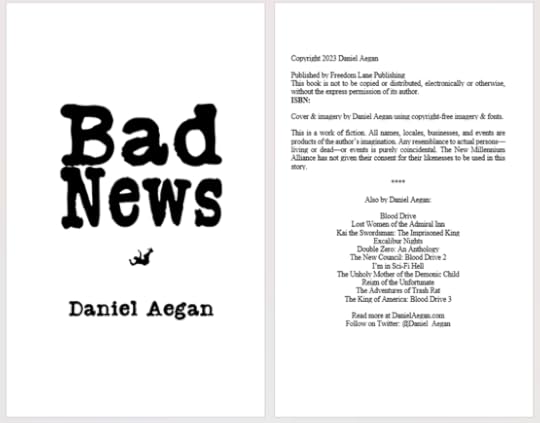
FYI: I call the title page a “splash page” based on comic books since that’s what they call the opening page. Please forgive me for this terminology if it doesn’t agree with you.
If you have a dedication for your book, you’d want to add it on the next page. This should be fairly obvious as most modern books have one. You may want to keep these pages unnumbered for aesthetics’ sake.
As one last note here as we’re talking page numbers, you can use the Next Page section break function to start page one where your story actually begins. When you do this, make sure you’re unchecking the box to match with the previous chapter where you want your first numbered page. This is the same for the page headers as well, and we’ll get more into them later. I won’t get into this more since I’m not sure how programs other than Word use this function.
Table of Contents
I do not typically do this unless I’m releasing a collection of short stories. Amazon recommends it for all books, especially ebooks, but it’s in no way required. If you can utilize hyperlinks, you can have an ebook where a chapter is a click away. Again, I don’t use this, so I don’t have a lot to say on this subject, but I’ve seen a lot of tutorials out there for the addition and utilization of links to go back and forth through your ebook. As far as a paperback table of contents, make sure the page numbers are correct before you put your book out into the world. If you change this information, make sure you update your table of contents to reflect the change.
Introduction/Forewords
I don’t recommend these unless you’re writing nonfiction. I’ve seen these go badly for indie writers. Some readers don’t want their experience encumbered by having these ahead of the story, and some will straight up shelf a book at the mere sight of it. There are also readers who do the same if they spot a prologue, but that’s a subject for another article. For the intents and purpose of this article, be careful when dropping these ahead of your story. The only time I ever put a foreword in a book is in short story collections.
I know this doesn’t have a lot to do with formatting, but I felt I should add it here. If you do add an intro to your book, you may want to have a different set of page numbering or exclude it here.
Page Width and Height
You should know this before you start formatting. This will determine your page size and also your cover. There are a wide array of sizes you can use with Amazon’s KDP or any other self-publishing service. The 6×9 size is listed as the most popular. I like the 5×8 for my books since it feels more portable this way. Change the paper size of your document to see how your text looks on the page of your planned book. When you know what looks best for you, save it for uploading. I change the paper size to 5×8 as I write to get a feel of my overall page count. You don’t need to do this yourself if you’re more comfortable keeping it 8.5×11 until you’re ready for the last step.
This, of course, leads directly to our next topic.
Margins
I’ll admit that this is the source of my most recent hangup and why I had to resubmit some of my books. Make sure you’re using your margins properly! These will vary depending on your page count and the size of the book overall. Using the minimum allowed is a good way to frame your page nicely. You don’t want too much blank space in your book!
When formatting for a paperback (ebooks don’t care about margins) make sure you’ve got it set up correctly. The example below is for a 5×8 book with 315 pages. The inside margin should be more due to the gutter in the middle of the book. These dimensions make it fit Amazon’s KPD requirements exactly, so they might be different if you’re publishing with a different company. The top and bottom margins aren’t as stringent, but I don’t like taking too much space away from my story’s text. We’ll look at headers and footers later since those will determine your top and bottom margins.
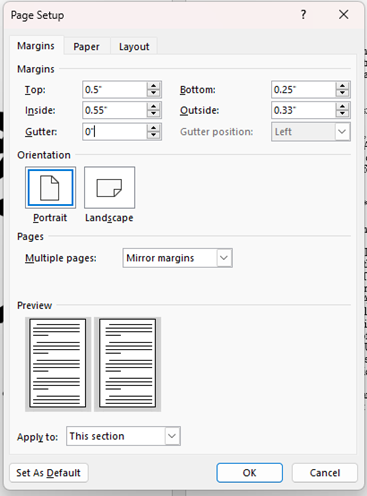
Font Type and Size
Don’t you dare publish your book in comic sans!
Seriously, though, pick a decent-looking font. Don’t use anything fancy you pulled off a website that looks cool but will take your reader out of the story while deciphering it. It may look cool but it’ll probably annoy your readers. Save that font for your chapter headers but not your story. Times New Roman is my go-to. Arial or something else appealing to the eye works as well.
Size it for the page, too. You don’t need gigantic letters unless you’re making a book for people with bad eyesight. Don’t make it so tiny your reader has to squint, either. For my 5×8 books, I go with a 10 font. It looks best on the page this way. Using an 11 or a 12 is OK, too, especially if you’re using the 6×9. This information is subjective, so do what looks best for you.
Page Numbers
You think this would be obvious, but I’ve had a few books come my way without page numbers anywhere on them. I’ve seen readers complain about this from indie authors as well. You have the option to put it at the top or the bottom as well as choosing to left, right, or center justify them. Putting them in the center of the footer is the most common way to do this, but there isn’t a wrong place for them since it’s another one of those subjective quirks.
Page Headers
Since we touched on footers in the last section, now feels like a good place to bring up page headers. You can have your page number up here if you’d like as mentioned. I like seeing the book title and author name up here. Maybe it’s something I got used to after years of reading since a lot of books don’t have it this way. This is one of those subjective things, too, so don’t stress if you’re not going with the flock on this one. You can use a separate header for even and odd pages, so they don’t have to be the same.
Here is an example of page headers:

Chapter Headers
You want to mark your chapters in case you have a reader flipping through them. If you have a header the same size and font as the rest of your book, the won’t stand out. This goes for part divisions or short story headers in collections as well, but we’ll lump them all in here.
I find the best way to make a good header is with a black and white graphic. This is how I also do the aforementioned splash pages and page headers. Size it right for your page, and insert the image. If you can’t make the graphics yourself, find someone who can. If you don’t have a friend who’s willing to help, you can hire someone with graphics know-how or trade services like beta reading. I’ve done formatting for friends in the past for similar service trades.
You can always up the font size for paperback, but this formatting may be erased on ebooks. If you add them as images on the page, they can’t be edited or removed on the back end when the digital formatting takes place.
Here are some examples of headers for new chapters, short stories in an anthology, and part dividers from my books:
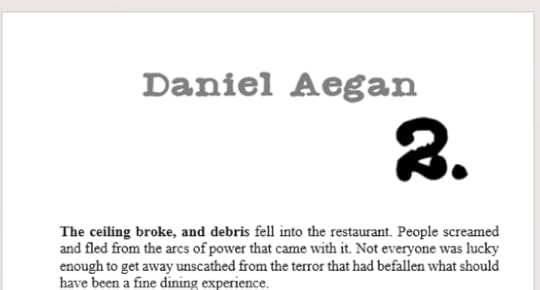
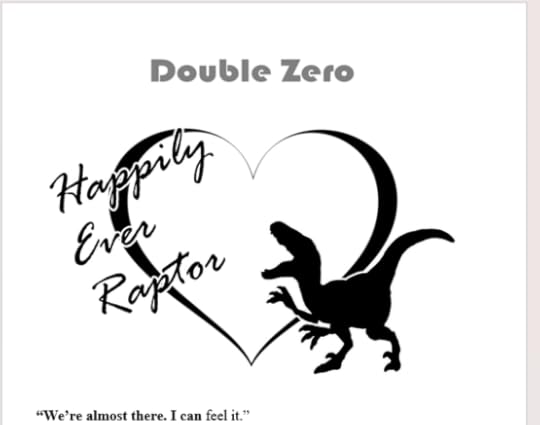
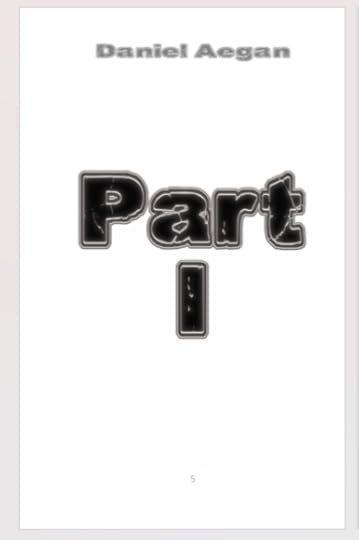
Blank pages
Remove them.
Justification
This is one of my biggest formatting peeves next to double-paragraph spacing when I pick up an indie book. You want your text to line up against the edge of your right and left margins. It makes the whole book look much neater and polished.
Unjustified:
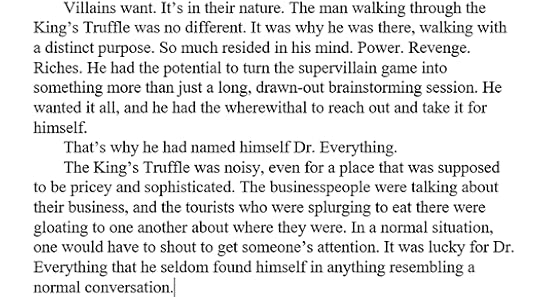
Justified:
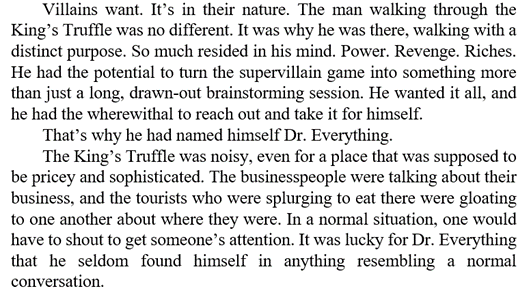
See how much better it looks in the second image! You can also use an auto-hyphenation feature for longer words at the far end of the righthand margin if you’re into that kind of thing.
About the Author Page/Afterwords
I debated whether or not to add this the first time I wrote this article. I hate writing about myself, and I tend to avoid it. I asked a few indie author pals, and the consensus was that this should most definitely be in the book and a part of this article. This section typically comes after our story and should include a short and sweet description of yourself. More than a few paragraphs feels like masturbation, though. Include a headshot if you want it to look extra professional.
You can also add some acknowledgments or an afterword at the end if you’re looking to drop some notes on your reader. If there was anyone who helped or some event that inspired you to write your story, now’s the time to mention them. I once saw a writer get completely eviscerated for putting this stuff ahead of the story, so make sure you’re doing this on the back end.
***
Well, that’s the list. I hope you’ve learned something new or used this to brush up on your formatting skills or at least pointed you in the right direction.
-Daniel Aegan
2/16/2023
August 27, 2022
Pickup Truck Dealers Fed Up with Fetishists Ejaculating onto Inventory
Note: This story was rejected by mainstream media due to the graphic nature of those covered by this report. Reader discretion is advised.
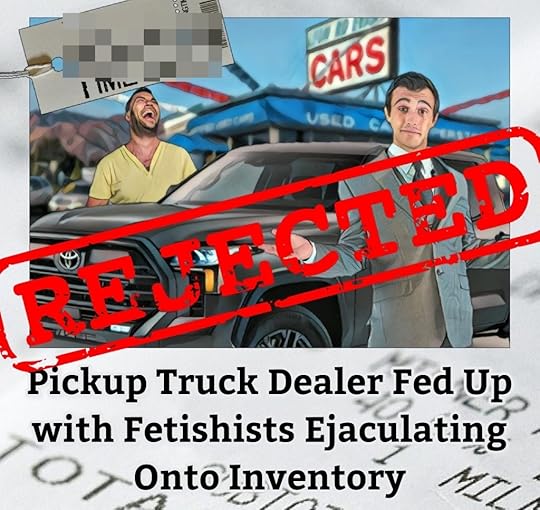
East Haven, CT
Jebidiah Cole has sold pickup trucks and pickup truck accessories his entire adult life. He inherited Cole Trucks from his father in 2004 after he suffered a heart attack at a barbecue. Ever since, Jeb’s been the proud owner of the pickup empire his father had built.
“I felt like a prince taking over a kingship,” Cole explained, standing in a lot full of pickup trucks for sale. “Losing my father was harsh, but taking over the business was something I’d always wanted. Just wish my old man had handed me the kingdom instead of getting it during the reading of his will.”
“I love selling pickup trucks so much,” Cole continued after we told him to stop being such a buzzkill. “Seeing the faces of my customers light up with the joy of buying a new truck—whether they’re men or masculine women—always brings joy to my heart. I can see why Dad loved it so much.”
But Cole would soon discover the dark side of being a pickup truck dealer.
“Jeb’s father shielded him from a lot of the shit that came along with the business,” Jillian Johansen, longtime employee of Cole Trucks said. “I mean, everyone knew what was happening, but we were all told Jeb didn’t need to be involved. Well, he found out what happens in this business the hard way. Boy, did he.”
“I was flabbergasted the first time it happened,” Cole said. “I had a customer in the lot, checking out a cherry-red Ford F-150. I thought the look on his face and the way he caressed the shining finish meant he wanted to buy it, and I hadn’t been prepared for what happened next.”
Cole looked away, swiping at his glassy eyes before he continued.
“The man pulled out the smallest pecker I’d ever seen and masturbated to completion right on the Ford’s grill.”
What Cole didn’t know till that moment was a pickup truck fetish had evolved in America. It had started as a culture of middle-aged men with small penises modeling their lives around pickup trucks they either owned or wished they owned. This soon became not enough, and pickup truck culture had turned into something darker and more insidious.
“That’s the day I started regretting taking over the family business.”
We spoke with Edward Gillian of Branford, CT—who asked to remain anonymous—about this phenomenon and his involvement in pickup truck fetishes or ‘pickupping’ as it became known as thanks to sites like FordChan.
“We all start the same way,” Gillian explained. “I used to look up pictures of pickup trucks late at night when my wife and kids went to bed, masturbating quietly with my micropenis under my desk. It didn’t take long for me to want something more, though. Fantasizing over pictures wasn’t enough. I had to take it to the next level, and I found a whole community of people just like me.”
Gillian referred us to sites on the dark web, dedicated to men with scraggly beards, cargo shorts, and novelty tee shirts who wanted the same as he did. They posted pictures of their handiwork, bragging about which pickup trucks on which they’d ejaculated, reveling in their disgusting actions. Some sites even had games for its denizens.
“I’m two trucks away from bingo!” Gillian bragged. “If I can pop my wad on a Dodge Ram and a Chevy Silverado, I’ll win a hundred dollar Burger King gift card!”
Not all stories are as positive as Gillian’s self-imposed quest for a Burger King gift card. Some pickuppers have harrowing tales of how things can go wrong.
“I like Fords for sure,” Timothy Guthrie told us. “Dodges are cool too. America first, baby!”
“I found a beauty of a Ford Maverick at a construction site,” Guthrie continued. “I couldn’t help myself. I pulled over, approached it, and started jacking my tiny peen with no regard for my surroundings.”
Guthrie didn’t consider the consequences for his disgusting actions. Four workers on the site jumped and proceeded to beat him.
“I woke up in the hospital two days later with three broken ribs, five missing teeth, a dislocated shoulder, and a bruised spine. Of course, no one at the construction site saw anything. They claimed they found me lying there for no reason when they took their lunch break.”
Guthrie wasn’t the only one who suffered because of their involvement in pickupping. Michael Herbert lost his job after a video of him dry-humping a GMC Canyon in a Wal-Mart parking lot surfaced online and went viral. He asked not to be part of this article, stating he just started a new job and doesn’t need his past ruining his reputation as he tries to rebuild it. Many pickuppers face the stigma of being part of the community in their everyday lives when outed.
“It’s not a perversion,” Gillain said after we admonished him for his perversions. “We can’t help it. We were born with an intense attraction to pickup trucks, and pickupping is the only way to satisfy that urge. It’s no different than any kink or fetish, and we’re hurting nobody.”
Gillian may believe that, but truck dealers like Jeb Cole would disagree. “It’s totally gross,” he replied when we played Gillain’s comments for him. “My employees have to clean that stuff up every time one of these pickuppers comes in and catapults their cookies all over my trucks. Imagine having to sell a truck to someone while you’re thinking about what some pervert did all over the hood the night before. It’s maddening!”
A week after we interviewed him, Jebidiah Cole was arrested for holding a pickupper party in the showroom of Cole Trucks with a group of men he met on FordChan. The police were called when a passerby noticed the men furiously masturbating around a black Ford F-350 Super Duty. Cole couldn’t be reached for comment, but we learned through social media that his wife left him with their three children and he closed his business after the embarrassing arrest and subsequent trial.
July 8, 2022
Story by Daniel Aegan (@…
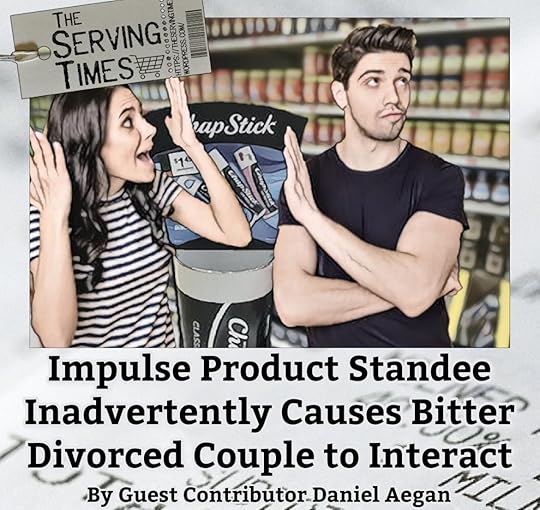
Story by Daniel Aegan (@Daniel_Aegan) A Chapstick standee in a suburban supermarket has come under scrutiny for causing a bitterly divorced couple to…
Story by Daniel Aegan (@…
March 23, 2022
Daniel’s Journal #71 – Incels, Snowflakes, and Cartoons
I’m so tired of these horrible incel takes on movies. I’m a middle aged dude who’s way more immature than other people my age, but I had no issue whatsoever with the latest Disney/Pixar movie Turning Red. To clarify, I’ve seen a handful of tweets and shared content about this movie full of anger and misplaced raged based on the subject matters. To clarify further, the subject matter is a thirteen year old girl who turns into a red panda. Think Teen Wolf if it were a tween drama.
This hot take I saw this morning stated that the panda was symbolic of the main character’s vagina, and the movie conditioned kids toward sex work since she sells photos and personal appearances in order to fund some boyband concert tickets. I’ve watched this movie, and I can say with all certainty ever certained that the “panda” is not symbolic for any kind of private parts. If anything, this change alludes to a girl’s transition into womanhood. Red panda = … You get the point. At least I hope so.
That being said, can we have any movie where the main character isn’t a straight white man that doesn’t get this treatment? This movie was fine. My kid and her friend with whom I watched it both loved it. Just because you can’t relate doesn’t make it a perverse narrative. I’ve recently spoken about the “this isn’t for you” phenomenon in my last blog post based on this same movie, but apparently this wasn’t enough. You can check it out here to catch up:
Daniel’s Journal #70 – Dealing with TIAMS and Its Victims
Here’s the thing about all this bullshit. If you’re a snowflake who’s easily offended by a movie meant to relate to young girls, then maybe skip movies like this. Maybe use that time to book a therapy session instead and try to find the root of what made you like this. If you’re seeing this movie as symbolism of girls’ privates and it puts your mind right to sex work, then most definitely do the therapy thing. Bro, you’ve got more issues than National Geographic.
This isn’t about Disney or Pixar or any production company being “woke” or pushing an agenda. It’s about your backwards-ass mindset that doesn’t allow you to take part in media that makes you feel things for people who aren’t you; people you’ve been conditioned to marginalize. Let’s say you wake up yourself to this conditioning at some point and you can see the world for the tapestry of deferences it is instead of viewing things from your glass house that smells like stale farts and ookie cookies.
That’s what pisses you off. If this movie was about a white boy who turned into a bear whenever he had a wet dream, you’d laud it as the best cartoon ever made. Granted, I may write that story now, but that’s not the point I’m trying to make. We could call it Turning Blue for reasons too gross to get into here.
But I digress.
It’s about time to wrap this up, so let me conclude by repeating something that no one who needs to hear will hear. I understand not liking things. There is plenty of media I don’t like. It’s not our place, however, to furrow our brows and try to make up disgusting reasons to hate a movie so adorably sweet that speaks to its target audience so well. There’s not doubt in my mind why my daughter and her friend liked it so much while I sat in the room with a meh expression. This wasn’t for me, and that’s OK. There is plenty of stuff that is for me, though, and I’m happy content like this is coming out more and more for people who feel like they don’t get plots in movies or storylines on TV shows to which they can relate. There are soooooo many reasons to not like Disney, but this isn’t one of them.
It’s a bad look, and no one wants incel culture. Pay attention to what’s being said about people who aren’t you in movies like Turning Red or any other media featuring women or people of color or those in the queer and trans community. It was never about the panda, a black Captain America, or queer characters on TV shows. It’s always been about your inability to accept that you share the world with people who aren’t you.
Daniel Aegan – 3/23/22

